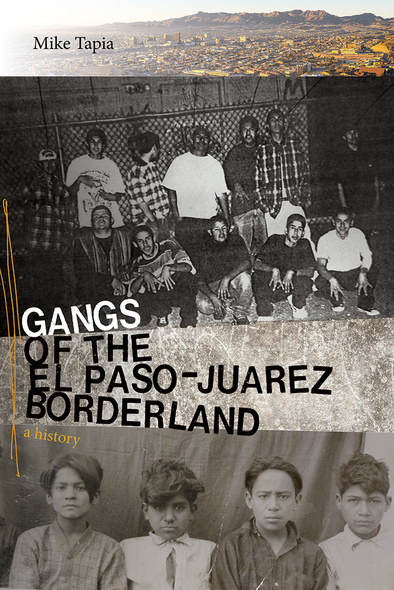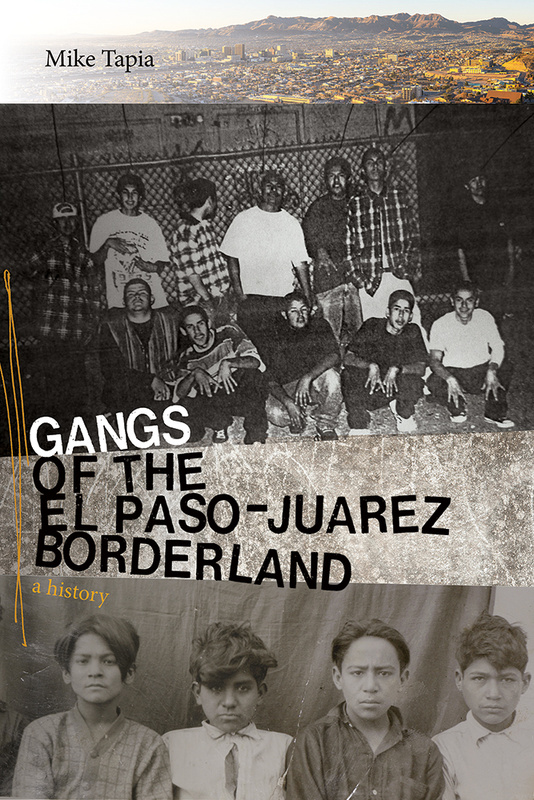
This thought-provoking book examines gang history in the region encompassing West Texas, Southern New Mexico, and Northern Chihuahua, Mexico. Known as the El Paso-Juárez borderland region, the area contains more than three million people spanning 130 miles from east to west. From the badlands—the historically notorious eastern Valle de Juárez—to the Puerto Palomas port of entry at Columbus, New Mexico, this area has become more militarized and politicized than ever before. Mike Tapia examines this region by exploring a century of historical developments through a criminological lens and by studying the diverse subcultures on both sides of the law.
Tapia looks extensively at the role of history and geography on criminal subculture formation in the binational urban setting of El Paso-Juárez, demonstrating the region’s unique context for criminogenic processes. He provides a poignant case study of Homeland Security and the apparent lack of drug-war spillover in communities on the US-Mexico border.
Gangs of the El Paso-Juárez Borderland provides an encyclopedic ‘inventory’ of the region’s gangs, including city-by-city and gang-by-gang profiles of membership and organization.
A nuanced look at gang development, culture, and crime that evenhandedly outlines the causes and consequences of gangs on the border, a force that is neither entirely catastrophic nor wholly benign, but a phenomenon born of complex socioeconomic, geographical, and historical processes and relationships.
Mike Tapia offers a seminal work on the history and significance of criminal subcultures in the borderlands.…Mainstream perceptions of gangs are often negative and one-dimensional. Tapia’s book contributes to scholarship that digs deeper to provide a richer sociocultural consideration of these subcultures.
Tapia excels at providing a descriptive overview of different communities and groups, uncovering a lot of unknown information about local gangs in this region of the country.
The best overview available on street gangs in this region of the country.…Tapia deserves high praise for doggedly sifting through a myriad of source material in order to piece together a history to a phenomenon that often escaped much documentation or critical analysis in the early decades of its formation.
The author’s fluid writing style and his meshing of the disciplines of criminology and history makes it a must-read for anyone who wants to understand the broader dynamics of gang evolution in the borderlands region.
Tapia's book is a rare and authoritative look at a unique and complicated subculture.'--Yvette Benavides, Book Public on Texas Public Radio
This engaging study of the rise and transformation of Chicano gangs and their criminal subculture along the border enriches a growing body of literature on the borderlands.…Recommended.
Explores one hundred years of a defiant, intriguing, and sometimes deadly urban social phenomenon.
Tapia provides a sorely needed supplement to our knowledge of gangs in the Southwest, giving us a detailed history of gang development, cartel and street-gang relations, and the evolution of street-prison gang hybrids in the El Paso, Las Cruces, and Juárez regions.
Very rarely do criminologists get to read an authoritative book by an authoritative scholar on a topic with great interest but little scholarly attention. Tapia’s book is a landmark achievement on the gangs of the El Paso-Juárez region in a one-hundred-year time period. You will not be able to put this book down.
Mike Tapia is an associate professor of criminology at New Mexico State University. He is the author of The Barrio Gangs of San Antonio, 1915â€"2015.
Acknowledgments
Introduction. The El Paso-Juárez Borderland as Place and Its Criminal Subcultures
Chapter One. The Early Barrio Gangs of El Paso, Texas: 1920s to 1950s
Chapter Two. A Gang History of Las Cruces, New Mexico
Chapter Three. Anthony, New Mexico: Influences and Network Linkages from All Directions
Chapter Four. Ciudad Juárez: The Epicenter Then and Now
Chapter Five. El Paso’s Modern Gangs and the Barrio Azteca
Chapter Six. The Role of History and Geography on Criminal Subcultures
Appendix A: Historical Street Gangs Inventory, El Paso
Appendix B: Historical Street Gangs Inventory, Juárez
Notes
References
Index




